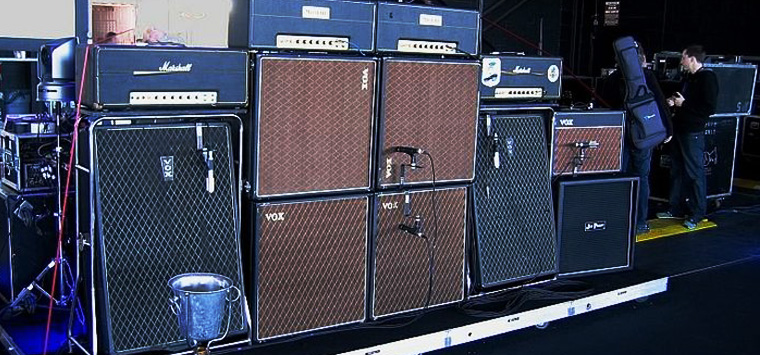
I hate these! I can’t ‘feel’ my guitar!
If you are a guitar player, and have never played in front of a wall of amps, you owe it to yourself to try that at least once. There’s really nothing like it… Being engulfed by sound waves can transport you.

This same/similar feeling is even achieved with one small amp in a small club. If the volume of the whole band is loud enough to fill up the room you can also create the ‘engulfed by’ feeling. This is a feeling we as musicians get used to, especially playing in a band. It makes the idea of playing as a unit, a well oiled machine that moves and breathes together, even more achievable and way more fun. This is what we come to expect.
Then, we get asked to do a gig where in-ear monitors are required or suggested for any number of reasons. We try to comply, but suddenly EVERYTHING seems different.
Getting past the perceived ‘downside’ of in-ear monitors
Missing that powerful feeling from the room can be a paralyzing change to a new IEM user. Feeling isolated and disconnected is another common hurdle to overcome. Couple that with maybe some signal dropouts, or that ‘paper-tearing’ sound when your unit is trying to grab onto the frequency… and you can have a VERY CRANKY MUSICIAN on your hands (ask me how I know this- I’ve got stories!).
The upside FAR outweighs the downside

I remember listening to whole albums when I was younger, headphones on, I would just get lost in the music, isolated from the world… and with good headphones, the sound was amazing!
Later, as a studio musician, I got used to having to ‘BRING IT!’ without the assistance of the crowd and the big immersive sound of the venue. Rather, I needed to get used to having the engineer get my mix as close to that sound I got listening to my albums, so I could immerse myself in that way… take me to “dreamland” so to speak.
Some ‘upside’ to balance the ‘downside’
- BAND
- Eliminate feedback
- Reduce stage clutter
- The ability to control your own isolated mix
- Mobility without losing your mix
- SINGERS
- Better able to control voice
- Seriously reduce or eliminate over singing and straining
- Make it easier to achieve a vocal blend
- SOLOISTS
- Creating a mix in your headphones/IEMs that is inspiring to you, as if you were in the studio or in that dream-state of listening to records in your headphones
Some helpful tips for acclimating to IEMs
- Comfort: IEMs can feel uncomfortable, especially if they don’t fit well. To overcome this, invest in custom-molded IEMs. These are made specifically for your ears and tend to be more comfortable. Alternatively, try different types of tips (foam or silicone) to find the best fit for your ears.
- Isolation: Some people find the isolation that IEMs provide to be a downside, as it can make them feel disconnected from their surroundings. To mitigate this, consider using IEMs with adjustable isolation, or use only one earpiece if situational awareness is necessary.
- Sound Quality: Poor sound quality can be a concern with some IEMs. To address this, invest in high-quality IEMs from reputable brands. Read reviews and seek recommendations from professionals in the music industry.
- Cost: Good IEMs can be expensive. However, it’s essential to view them as an investment in your audio experience. Look for mid-range options that balance cost and quality. Additionally, consider the long-term savings in hearing protection by using IEMs.
- Maintenance: IEMs require regular cleaning and maintenance. Clean the tips and earpieces regularly to prevent earwax buildup, which can affect sound quality. Proper care can extend the lifespan of your IEMs.
- Getting Used to the Feeling: Some people take time to get used to the sensation of having something in their ears. Start by wearing your IEMs for short periods and gradually increase the duration to acclimate yourself.
- Communication: Communication can be challenging with IEMs, especially in live music settings. Invest in a good communication system or use a clear communication protocol with your bandmates and sound engineer to overcome this issue.
- Environmental Sound: In some situations, you may need to hear environmental sounds. In such cases, you can opt for IEMs with adjustable isolation or use one earpiece.
- Education and Practice: Learning how to use IEMs effectively can take time. Take the time to educate yourself on proper usage and practice using them in different settings to get the best results.
- Custom Mixes: IEMs allow for custom mixes, which is a significant advantage. Work with your sound engineer to create the best mix for your needs, and practice with it to get used to the sound.
- Hearing Protection: Remember that IEMs can also be used for hearing protection. They can reduce your exposure to loud sounds, which can be a significant benefit in loud environments.

Getting past the perceived downsides of in-ear monitors is often a matter of adjustment, education, and finding the right IEMs that suit your needs and preferences. Over time, most users come to appreciate huge upside that IEMs offer in terms of sound quality, customization, and hearing protection.
